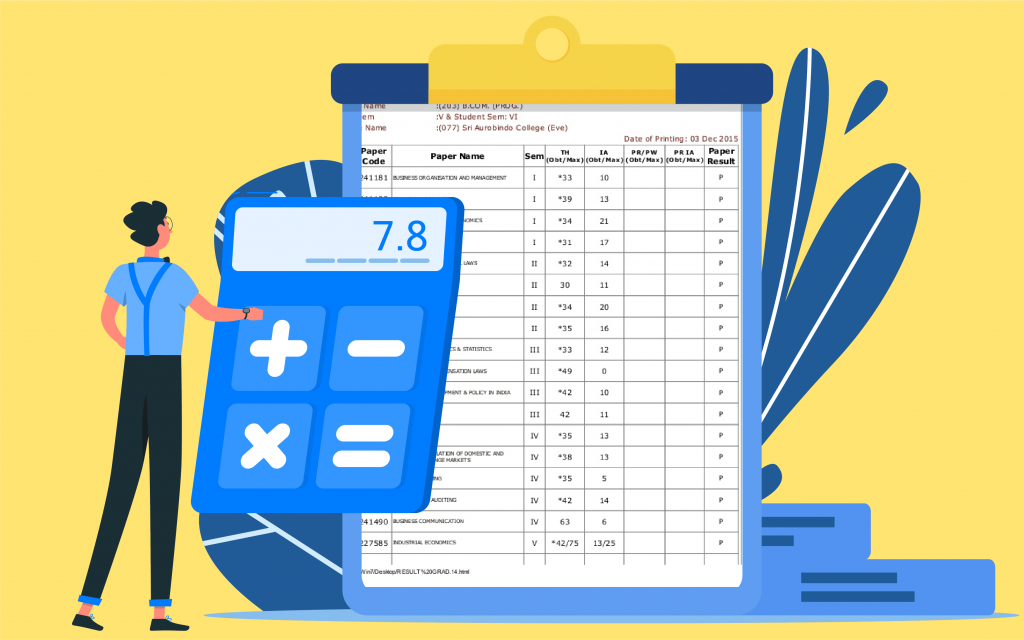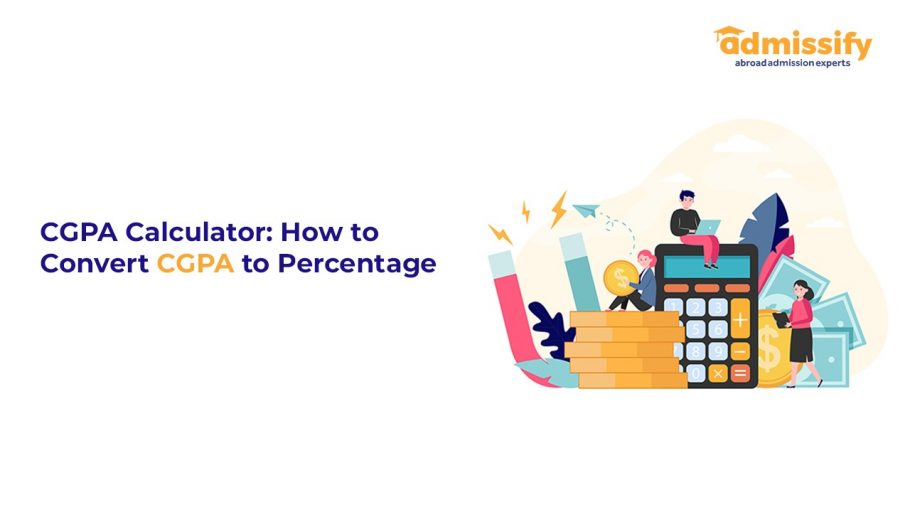Last Updated on August 30, 2024
Calculating Cumulative Grade Point Average (CGPA) is a common practice to assess students in educational institutions worldwide. However, when it comes to presenting academic achievements or meeting certain eligibility criteria, many institutions require conversion of CGPA to percentage. Understanding the process of converting CGPA to percentage is essential for students aiming to showcase their academic performance accurately.
CGPA to percentage is calculated by multiplying your CGPA by 9.5. For Example, if you got a CGPA of 8 then your percentage would be 8*9.5 = 76%. This article serves as a comprehensive guide, providing step-by-step instructions on how to convert CGPA to percentage.
We will explore the underlying principles, formulas, and considerations involved in this conversion, helping students navigate this crucial aspect of academic evaluation. By delving into the specifics, we aim to simplify the process and empower students with the necessary knowledge to accurately convert their CGPA to percentages and present their achievements effectively.
What is CGPA?
CGPA stands for Cumulative Grade Point Average. It is a grading system used in educational institutions to measure a student’s overall academic performance. Unlike traditional percentage-based grading systems, CGPA is based on a scale or point system. Each course or subject is assigned a certain number of credit hours and a corresponding grade based on the student’s performance. The grades are typically represented by letters such as A, B, C, and so on, or by numerical values. The CGPA is then calculated by averaging the grade points earned in all the courses taken by a student over a specific period. It provides a cumulative measure of the student’s academic achievements and is often used for assessing eligibility for scholarships, honors, and admissions to higher education programs.
How to Calculate CGPA from Percentage?

To calculate CGPA from a percentage, you need to follow these steps:
Step 1: Understand the grading scale:
Different institutions may have different grading scales. Typically, a 10-point scale is used, where grades range from 10 (highest) to 0 (lowest). Familiarize yourself with the specific grading scale used by your institution.
Step 2: Convert the percentage to a grade point:
Using the grading scale, convert the percentage obtained in a particular subject or course to the corresponding grade point. For example, if the percentage falls between 90% and 100%, it may be converted to a grade point of 10.
Step 3: Calculate the Grade Point Average (GPA):
Add up the grade points earned in all the subjects or courses and divide the sum by the total number of subjects or courses taken. This will give you the GPA.
Step 4: Calculate the CGPA:
The CGPA is obtained by averaging the GPAs obtained over a specific period. This can be done by adding up the individual GPAs and dividing the sum by the total number of terms or semesters.

Examples to Convert Percentage to CGPA
| Example 1 If Rohit has secured 85% in an academic session, his CGPA would be: 85 / 9.5 = 8.9 |
| Example 2 If Gaurav secured 70% and wants to convert the percentage to CGPA then it would be: 70 / 9.5 = 7.4 |
Percentage to CGPA: Grade & Remarks Table
Certainly! Here’s an updated table with an additional column for the corresponding letter grade:
| Percentage Range | CGPA | Grade | Remarks |
| 90% – 100% | 10 | A+ | Excellent |
| 80% – 89.9% | 9 | A | Very Good |
| 70% – 79.9% | 8 | B+ | Good |
| 60% – 69.9% | 7 | B | Above Average |
| 50% – 59.9% | 6 | C+ | Average |
| 40% – 49.9% | 5 | C | Below Average |
| 30% – 39.9% | 4 | D | Poor |
| 20% – 29.9% | 3 | E | Very Poor |
| 10% – 19.9% | 2 | F | Extremely Poor |
| 0% – 9.9% | 1 | F | Fail |
The additional “Grade” column represents the letter grade corresponding to each CGPA
CGPA to Percentage Conversion Table from 10 to 1 CGPA
Here is the detailed CGPA to percentage conversion table that shows you all the conversions from 10 – 1 CGPA. Take a look at the table below.
| CGPA | Percentage (%) | CGPA | Percentage (%) |
| 10 | 95% | 6.9 | 65.55% |
| 9.9 | 94.05% | 6.8 | 64.6% |
| 9.8 | 93.1% | 6.7 | 63.65% |
| 9.7 | 92.15% | 6.6 | 62.7% |
| 9.6 | 91.2% | 6.5 | 61.75% |
| 9.5 | 90.25% | 6.4 | 60.8% |
| 9.4 | 89.3% | 6.3 | 59.85% |
| 9.3 | 88.36% | 6.2 | 58.9% |
| 9.2 | 87.4% | 6.1 | 57.95% |
| 9.1 | 86.45% | 6 | 57% |
| 9 | 85.5% | 5.9 | 56.05% |
| 8.9 | 84.55% | 5.8 | 55.1% |
| 8.8 | 83.6% | 5.7 | 54.15% |
| 8.7 | 82.65% | 5.6 | 53.2% |
| 8.6 | 81.7% | 5.5 | 52.25% |
| 8.5 | 80.75% | 5.4 | 51.3% |
| 8.4 | 79.8% | 5.3 | 50.35% |
| 8.3 | 78.85% | 5.2 | 49.4% |
| 8.2 | 77.9% | 5.1 | 48.45% |
| 8.1 | 76.95% | 5 | 47.5% |
| 8 | 76% | 4.9 | 46.56% |
| 7.9 | 75.05% | 4.8 | 45.6% |
| 7.8 | 74.1% | 4.7 | 44.65% |
| 7.7 | 73.15% | 4.6 | 43.7% |
| 7.6 | 72.2% | 4.5 | 42.75% |
| 7.5 | 71.25% | 4.4 | 41.8% |
| 7.4 | 70.3% | 4.3 | 40.85% |
| 7.3 | 69.35% | 4.2 | 39.9% |
| 7.2 | 68.4% | 4.1 | 38.95% |
| 7.1 | 67.45% | 4 | 38% |
| 7 | 66.5% |
Benefit of CGPA to Students & Educational Institutions
CGPA (Cumulative Grade Point Average) offers several benefits for students and educational institutions:
- Standardized Evaluation: CGPA provides a standardized evaluation of a student’s academic performance. It takes into account the overall performance across multiple subjects or courses, allowing for a comprehensive assessment.
- Holistic View: CGPA considers grades obtained in various subjects, reflecting the student’s overall understanding and performance across different areas of study. It offers a holistic view of the student’s capabilities and achievements.
- Simplifies Comparison: CGPA simplifies the comparison of students’ performance, as it provides a numerical representation that can be easily compared and understood. It facilitates fair evaluations for scholarships, admissions, and job placements.
- Flexibility in Course Selection: CGPA enables students to choose elective courses based on their interests and strengths without worrying about the impact on their overall grades. It encourages students to explore diverse subjects and develop a well-rounded skill set.
- Academic Progress Tracking: CGPA allows students to monitor their academic progress over time. By comparing CGPA from different semesters or years, students can gauge their improvement, identify areas of strength, and focus on areas that need improvement.
- Transparency and Accountability: CGPA promotes transparency and accountability in the education system. It ensures that grading is based on objective criteria and that students are evaluated consistently across subjects, minimizing biases and subjective judgments.
- Easy Conversion: CGPA can be easily converted to percentage or GPA (Grade Point Average) as required by different institutions or systems. This flexibility allows students to communicate their academic achievements effectively in various contexts.
- Recognition of Continuous Effort: CGPA recognizes the cumulative efforts of students throughout their academic journey. It acknowledges consistent performance and incentivizes continuous learning and improvement.
- International Comparability: CGPA provides a means of comparability between different educational systems globally. It enables institutions and employers to understand the academic achievements of students from diverse backgrounds.

Read Also
The Role of Online IELTS Practice Tests in Exam Preparation: Top Resources and Strategies
How to get job in USA for Indian in 2023: A Helpful Guide for USA Job Seekers
Minimum IELTS Score for Australian Universities, Courses, Student Visa & PR
Minimum IELTS Score for Canada Immigration for PR, Courses & Universities in 2023
How Long Does It Take to Prepare for IELTS? A Guide to Setting Realistic Study Goals
Difference Between CGPA to GPA
| CGPA | GPA | |
| Purpose | Measures cumulative performance over time | Measures performance for a specific term |
| Context | Often used in credit-based curriculums | Commonly used in semester-based curriculums |
| Scale | Typically on a 10.0 scale | Typically on a 4.0 scale |
| Calculation | Weighted average of grade points | Weighted average of grade points |
| Course Evaluation | Each course usually assigned a grade point | Each course usually assigned a grade point |
| Time Span | Spans multiple semesters or academic years | Covers a specific semester or term |
| Weighting | Course weight based on credit hours | Course weight based on credit hours |
| Commonly Used Region | Common in many countries outside the U.S. | Commonly used in the United States |
CGPA and GPA are both grading systems used to assess academic performance, but they are typically associated with different educational contexts:
- CGPA (Cumulative Grade Point Average):
- CGPA is commonly used in educational systems that follow a credit-based curriculum, such as universities or colleges.
- It calculates the average performance across multiple semesters or academic years.
- CGPA is often on a scale of 10.0, where each course is assigned a grade point (usually ranging from 0 to 10) based on the student’s performance in that course.
- The final CGPA is calculated by taking the weighted average of the grade points earned in each course, with the weight usually being the number of credit hours assigned to the course.
2. GPA (Grade Point Average):
- GPA is predominantly used in educational systems that follow a semester-based curriculum, particularly in the United States.
- It measures the average performance for a specific semester or term.
- GPA is typically calculated on a scale of 4.0, where each course is assigned a grade point (usually ranging from 0 to 4) based on the student’s performance.
- The GPA is calculated by taking the weighted average of the grade points earned in each course, with the weight often being the number of credit hours assigned to the course.
While both CGPA and GPA reflect academic performance, CGPA is associated with a cumulative assessment over multiple semesters or academic years on a scale of 10.0, whereas GPA is focused on a specific semester or term on a scale of 4.0. It’s important to note that grading scales and calculation methods may vary between institutions and countries.
SGPA to Percentage
To calculate the percentage equivalent of SGPA (Semester Grade Point Average), you can follow these steps:
- Obtain the SGPA for the specific semester.
- Convert the SGPA to a corresponding percentage using the following formula:
Percentage = SGPA * 10
For example, if the SGPA for a semester is 8.5, the corresponding percentage would be:
Percentage = 8.5 * 10 = 85%
Therefore, an SGPA of 8.5 would be equivalent to 85% in terms of percentage.
It’s important to note that this conversion formula may vary depending on the grading system and policies of your institution. It’s recommended to consult your institution’s guidelines or grading regulations for the precise conversion scale used for SGPA to percentage calculation.
CGPA to Percentage for Indian University
CGPA to Percentage for Mumbai University:
Mumbai University is one of the oldest and most renowned universities in India, offering various undergraduate and postgraduate programs across multiple disciplines.
The conversion formula used by Mumbai University is straightforward: Percentage = CGPA * 10.
CGPA to Percentage for VTU (Visvesvaraya Technological University):
VTU is a well-known technical university located in Karnataka, India, focusing on engineering and technology education.
To convert CGPA to the percentage at VTU, the formula used is Percentage = CGPA * 9.5.
CGPA to Percentage for GTU (Gujarat Technological University):
GTU is a state-level university in Gujarat, India, offering programs in engineering, pharmacy, management, and other technical fields.
- The conversion formula used at GTU is Percentage = CGPA * 8.8.
CGPA to Percentage for CBSE (Central Board of Secondary Education):
CBSE is a national-level board of education in India, that conducts examinations for schools affiliated with it.
CBSE provides a specific conversion scale for converting CGPA to percentage, which may vary depending on the guidelines issued by the board.
SPPU (Savitribai Phule Pune University):
SPPU, formerly known as Pune University, is a prestigious university in Maharashtra, India, offering diverse academic programs.
The conversion formula used by SPPU is the same as Mumbai University: Percentage = CGPA * 10.
CGPA to Percentage Anna University
Anna University, located in Tamil Nadu, India, is a renowned technical university offering various undergraduate and postgraduate programs. To convert CGPA (Cumulative Grade Point Average) to the percentage at Anna University, the following formula is typically used:
Percentage = CGPA * 10
For example, if Anna University student Anna has a CGPA of 8.5, her percentage would be calculated as:
Percentage = 8.5 * 10 = 85%
Therefore, Anna’s CGPA of 8.5 would be equivalent to 85% in terms of percentage at Anna University.
FAQ: CGPA to Percentage Conversion and Calculation
How to convert CGPA into a percentage out of 4 subjects?
To convert your CGPA into a percentage out of 4 subjects, multiply your CGPA by 9.5. For example, if your CGPA is 8.2, the equivalent percentage would be 8.2 * 9.5 = 77.9%.
How to convert CGPA into a percentage in engineering?
The conversion of CGPA into percentage in engineering typically follows the same formula as mentioned above. Multiply your CGPA by 9.5 to obtain the equivalent percentage.
How to calculate CGPA from marks?
To calculate CGPA from marks, refer to your institution’s grading scale, which assigns grade points to different ranges of marks. Calculate the average grade points obtained across all subjects to obtain the CGPA.
How to convert CGPA into marks?
Conversion of CGPA into marks may vary depending on the specific grading system of your institution. Refer to your institution’s guidelines or consult with the academic authorities for the precise conversion scale.
What is the equivalent percentage for 10 CGPA?
When converting a 10-point CGPA to a percentage, the equivalent percentage is generally considered to be 95% or above. However, specific conversion scales may vary between institutions.
How do you calculate GPA and CGPA?
GPA (Grade Point Average) is calculated by dividing the sum of the product of credits and grade points earned in each subject by the total credits. CGPA (Cumulative Grade Point Average) is the average of GPAs obtained across multiple semesters or terms.
Is a 6.9 CGPA good?
The perception of a “good” CGPA may vary depending on individual perspectives and the grading system of your institution. It’s advisable to check your institution’s guidelines or consult with academic advisors to assess the significance of a 6.9 CGPA in your specific context.
What is the equivalent percentage for a 7 CGPA?
To convert a 7-point CGPA to a percentage, multiply it by the appropriate conversion factor. Generally, multiplying by 9.5 can provide an approximate equivalent percentage.
Are the conversion formulas the same for all institutions?
No, the conversion formulas may vary between institutions and educational systems. Each university or board may have its own specific conversion scale and guidelines.
Can the CGPA to percentage conversion vary for different subjects or programs?
In most cases, the CGPA to percentage conversion is applied uniformly across all subjects or programs within an institution. However, specific grading policies may vary for different programs or departments.
How to calculate CGPA in Class 12 CBSE?
CGPA is a cumulative average of grade points obtained across subjects, while the overall percentage is the equivalent percentage based on the CGPA. To calculate the overall percentage, multiply the CGPA by 9.5.
Avinash Singh is a study abroad consultant with over 10 years of experience helping students achieve their academic goals. He is an expert in the US, Australian, German, and Canadian education systems and has helped hundreds of students secure admission to top universities around the world. In his spare time, Avinash enjoys traveling, hiking, and spending time with his family. He is also an avid reader and loves to learn new things.




